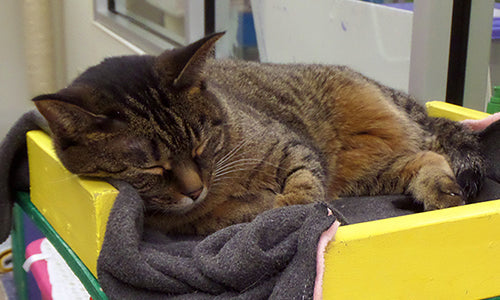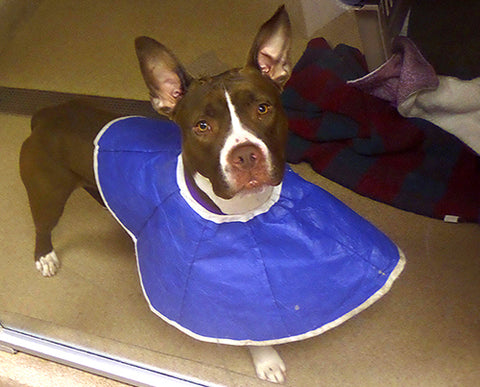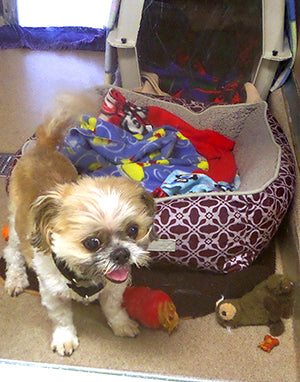
How Maintaining a Clean Humane Society Keeps Pets Healthy
If cleaning up after one or two pets is tricky, try 180. Oshkosh Area Humane Society in Oshkosh, Wisconsin has a fair share of messy monsters, but its staff must maintain a sanitary environment for its furry dwellers and prospective adopters.
"The number one thing is, with people coming to a shelter, if they're assaulted with smells and stink, that reflects poorly on who you are," said executive director Joni Geiger.
Here is how OAHS keeps its mansion of mammals in purrrfect shape.
Super cuddlers in...
When traumatized rescue animals enter an unfamiliar shelter, they get stressed. The key is to assign the animals relaxing placements. Dogs occupy only 10-20% of OAHS and get their own kennels. Cats move into kitty condos if they're antisocial or community rooms of 3-12 similarly-aged felines if they can tolerate interaction.

Chewpaca, a 5-year-old domestic short-haired cat, watches nature scenes on his TV. TVs keep OAHS cats healthy by boosting their spirits.
Geiger said boredom and stress are the two biggest problems for shelter animals. So volunteers walk the dogs every morning, while the indoor-centric cats enjoy toys, climbing towers...and another notable luxury.
"People think that it's kind of silly, but we have TVs in their rooms. It's very important to stimulate," Geiger said. Their primetime lineup consists of waterfalls, forests, small birds and geese.
Entertaining the animals plays two roles in the facility's cleanliness. First, the happier the pets are, the less anxiety-induced vomit or diarrhea the staff cleans up. Second, living in close proximity with other pets increases the risk of illness or disease, so stimulation helps keep their immune systems active. Shelter kittens are susceptible to upper respiratory infections like calicivirus and herpesvirus, while puppies can contract distemper or parvo.
...Super germs out
"Disease control is paramount," Geiger said.
Six workers spend four hours each day disinfecting different surfaces. A schedule tells cleaners which one or two of these four agents they'll use for the day: veterinary disinfectant, soap, bleach and/or a degreaser. Rotation prevents targeted bacteria and viruses from mutating into chemical-resistant super germs.
When using these products, medical coordinator Rhonda Velie said OAHS is mindful to rinse the surface after the products settle and before they dry. Some shelters take shortcuts by masking odors instead of disinfecting surfaces. Or they won't take the time to rinse a chemical after laying it, putting at risk the animals who lick or smell the dangerous mixtures.
"To their defense, they're nonprofits. Some people are getting 30 animals a day and they just don't have time. It's just that crazy in the business," Velie said.

Velie said achieving the correct chemical dilution is important with concentrates, particularly around cats and small mammals with sensitive noses.
"You can actually deplete their immune system by just kind of burning it right out of their nose if you use something too strong," said Velie.
Workers wash their hands between every pet they handle because humans are the biggest animal disease carriers. Caretakers handle a number of sick cats and dogs daily and may transmit germs by holding animal after animal.
Cleaning the living spaces, by animal
Snickers, a 10-year-old shih tzu, needs his kennel power cleaned daily because he likes to leap against the glass door.
- Cats rely on scent, so they feel lost when freshening removes their odors. Workers keep the scent lingering by only wiping surfaces one day and power cleaning the next day. Power cleaning includes washing bedding and cleaning the floors with Swiffers.
- Dogs rely more on sight, so maintaining scent isn't important. Workers strip dog kennels and power clean them daily. Cleaning up after canines involves scrubbing the walls, glass doors and bars because they love to jump.
- Small mammals like rabbits and mice stink because Geiger said they are "constant poopers," so their cages get cleaned twice daily. These critters, like cats, are sensitive to smell. Workers coat cage floors in hay and aspen wood chips, not cedar chips, which are widely used by small mammal owners. Cedar is too aromatic for small mammals, Velie said.
Keeping OAHS clean and presentable to the public pays off. The no-kill shelter has an 86% live release rate, Geiger noted, and animals find a home in an average of 17 days after hitting the adoption floor.
"I always say there's somebody for everybody," Geiger said.

 Protect & Save with SuperFreak.
Protect & Save with SuperFreak.